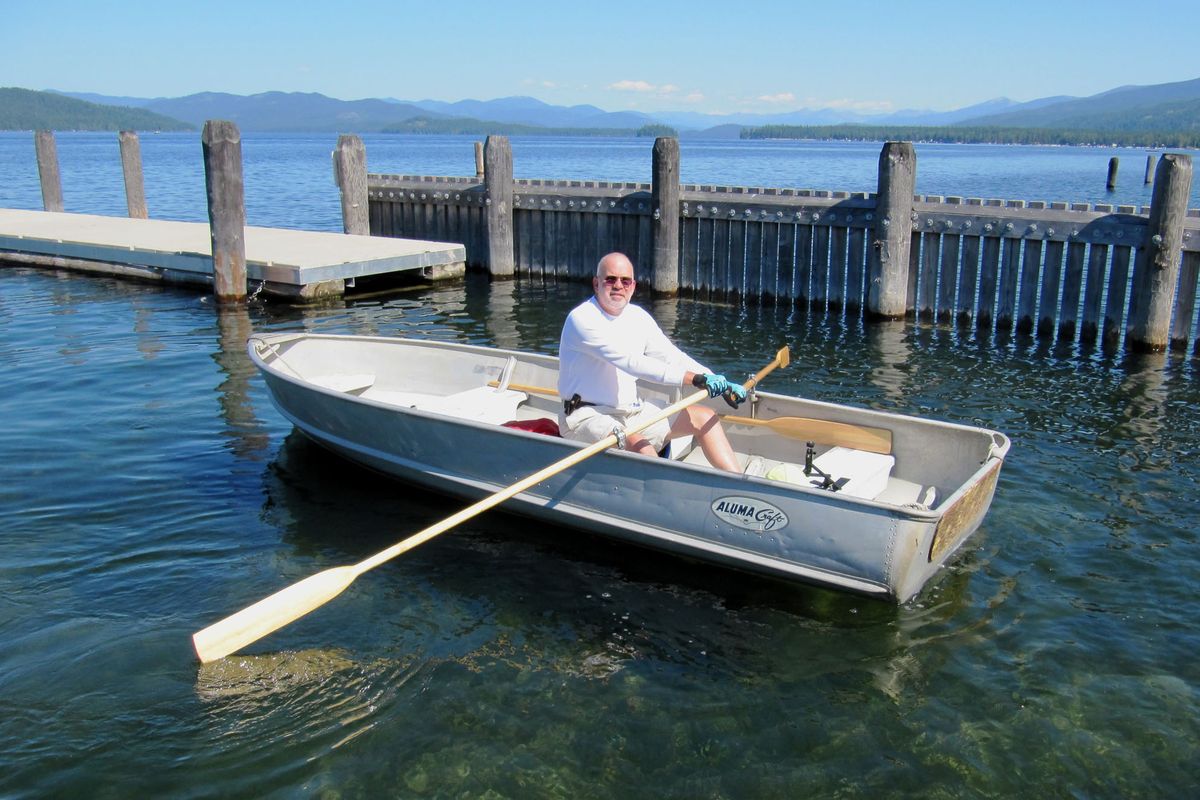Man takes spartan approach to row length of Priest Lake

His recent feat has left reasonable people thinking Stan Bech has only one oar in the water.
But if that were the case, he never could have rowed the length of Priest and Upper Priest lakes on a clear August day and night.
“I can’t run marathons or hike the Pacific Crest Trail,” the Spokane man said. “My knees are shot, probably from years of running and hiking. I had to look for another challenge.”
Rowing 31 miles might not seem extreme to someone accomplished at sculling, such as his daughter, who rows for the University of Washington.
But Bech did it the hard way in a 1969 Alumacraft rowboat, one of several to reside at the family’s Eight Mile Island cabin to grace their lake life over the decades.
At 14 feet long and built with the beam of a barge to hold coolers, fishing gear and a dog or two, the vessel lacks any hint of the speed and performance a rowing boat can assume from a long hull and high-tech design.
Bech sought no advantage from carbon-fiber oars, going instead with traditional 8-foot ash oars with enough beef to ward off moose and bears in the darkness to come.
Even ancient galleys were designed so rowers could sit on skins and slide back and forth with each stroke to harness the power of their legs.
Bech just sat his butt on a life jacket and pulled with his arms.
“Did I mention my knees are shot?” he said.
The Big Row wasn’t his maiden voyage.
“I’ve been doing long rows for several years,” he said, noting that he gradually learned little lessons, such as how much better a 14-foot boat handles big waves compared with a 12-footer.
“I worked up to three hours at a time, and last year I challenged myself to four hours in a 30 mph wind. It wasn’t like the ocean, but you had to be on the oars every second or the boat would whip around.”
Buoyed with a lifetime of experience and a little training, the obvious next step was to row everything Priest Lake had to offer.
His friend Allen Vinther shuttled him to Coolin at the south end of the lake on a nice August morning and Bech was off. The planning wasn’t much beyond that.
He didn’t even shove off until 10:30 a.m.
Provisions could have included sandwiches, Powerbars and energy gel. Instead, he went with six apples, six bananas, four oranges, some jerky, two MREs (meals ready to eat) and less than a gallon of warm water.
A jacket, wind pants and headlamp were stuffed under the bow and an extra pair of oars were stashed under the gunnels. He wore a video camera on his hat.
That was it. Spartan.
The boat was tricked out with only two modern conveniences: a rearview mirror to help him track straight down the lake and battery-powered running lights.
Reviewing Bech’s video is like watching a man hoe corn from a classroom where a kid is scraping his fingernails down a blackboard.
Oarlocks squeak. Water laps at the hull. That’s it.
“After a while,” he said, “I’d look back to where I started and think, ‘Wow, I came all that way, one stroke at a time.’ ”
Powerboats passed, but nobody motored up to ask Bech what he was doing. He was just an anonymous guy rowing out in the middle of a huge lake.
He’d sought no pledges to cure cancer. He wasn’t suffering this hardship in memory of a fallen friend.
He was just doing it.
Even with breaks at Four Mile Island, Bartoo Island and Cape Horn, he rowed the 19 miles to the north end of the main lake by 6:30 p.m. At 7, he pointed his bow into the slight current of The Thorofare, the serpentine channel that runs about 3 miles to the 3.5-mile long upper lake.
A couple paddling inflatable kayaks down from Upper Priest were the first strangers to show any interest in The Big Row.
“They heard the screeching of my oarlocks for quite a ways before they saw me and they were a little concerned about what sort of creature was coming up The Thorofare,” he said.
“They asked me were I’d come from. When I told them I started at Coolin they just said, ‘No way,’ and kept paddling.”
Around 9:30 p.m., at the last gasp of twilight, Bech nosed his boat into the brush at the north end of Upper Priest.
He ate and then arranged his four oars to make a bed for a nap.
“That didn’t work so well, so I decided to start heading out,” he said.
“I had running lights for the boat, so I was OK to keep going.”
From the middle of the upper lake, he could define the mountain tops and the sky, but when he found his way into the The Thorofare, he was in pitch black.
“There was no moon,” he said. “It as inky dark. I tried to doze off a few times, but couldn’t.”
He would swing his headlamp from side to side in the calm blackness expecting to see the shine of big eyes along the shore.
“The anticipation was always there,” he said. “But I never saw a critter.”
Nothing large and furry interpreted the screeching oarlocks as a mating call, and he was OK with that.
He beached on the sandbar at the mouth of The Thorofare at 4:15 a.m., where he watched the sunrise over an epically blue and smooth-as-glass lake.
He had only a few quiet hours before Vinther was scheduled to pick him up.
“I wore cycling gloves,” he said. “My hands were sore, but I didn’t have a single blister.
“Three days later the aches were gone and I was almost ready to do it again.”